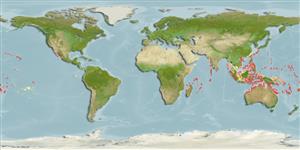Environment: milieu / climate zone / depth range / distribution range
Ecologia
marinhas associadas(os) a recifes; intervalo de profundidade 1 - 25 m (Ref. 9710). Tropical; 31°N - 23°S
Indo-West Pacific: Mauritius, Christmas Island, southern Japan, Marcus Islands, southern Taiwan, Australia, New Caledonia, Marshall Islands, Johnston Island, and Hawaiian Islands; distribution anti-equatorial. Recently reported from Tonga (Ref. 53797). Replaced by Pervagor marginalis in the Line and Marquesas Islands (Ref. 37816).
Tamanho / Peso / Idade
Maturity: Lm ? range ? - ? cm
Max length : 13.0 cm TL macho/indeterminado; (Ref. 30874)
Espinhos dorsais (total) : 1 - 2; Raios dorsais (total) : 31 - 35; Espinhos anais: 0; Raios anais : 28 - 32. First dorsal spine strong. Posterior margin of ventral flap narrowly attached to large pelvic fin rudiment. Scale spinulation in midbody not closely packed. Body and head color variable; orange to brown iris; caudal fin yellow or orange; soft dorsal and anal fins clear to yellowish; spinous dorsal dark brown to brownish orange; pectorals clear. Numerous spots in head and body appear as dashes or lines Male scale ridge rugosities usually develop at about 60 mm SL.
Inhabits clear lagoon and seaward reefs (Ref. 9710). Solitary among coral and rubble (Ref. 90102). Benthopelagic (Ref. 58302).
Ciclo de vida ou comportamento de acasalamento
Maturidade | Reprodução | Desova | Ovos | Fecundidade | Larvas
Hutchins, J.B., 1986. Review of the monacanthid fish genus Pervagor, with descriptions of two new species. Indo-Pac. Fish. (12):35 p. (Ref. 527)
Status na Lista Vermelha da UICN (Ref. 130435: Version 2024-1)
Ameaça para os humanos
Harmless
Uso pelos humanos
Ferramentas
Relatórios especiais
Baixar XML
Fontes da internet
Estimates based on models
Preferred temperature (Ref.
123201): 25.2 - 29.3, mean 28.4 °C (based on 2416 cells).
Índice de diversidade filogenética (Ref.
82804): PD
50 = 0.5039 [Uniqueness, from 0.5 = low to 2.0 = high].
Bayesian length-weight: a=0.01995 (0.00956 - 0.04164), b=2.93 (2.76 - 3.10), in cm total length, based on LWR estimates for this (Sub)family-body shape (Ref.
93245).
Nível Trófico (Ref.
69278): 2.9 ±0.4 se; based on size and trophs of closest relatives
Resiliência (Ref.
120179): Elevada, tempo mínimo de duplicação da população menor que 15 meses (Preliminary K or Fecundity.).
Fishing Vulnerability (Ref.
59153): Low vulnerability (10 of 100).
Nutrients (Ref.
124155): Calcium = 81.4 [34.6, 206.7] mg/100g; Iron = 0.842 [0.379, 1.975] mg/100g; Protein = 17.9 [15.7, 20.1] %; Omega3 = 0.108 [0.050, 0.226] g/100g; Selenium = 27.4 [13.1, 63.0] μg/100g; VitaminA = 70.8 [19.7, 262.7] μg/100g; Zinc = 1.65 [1.06, 2.63] mg/100g (wet weight);
